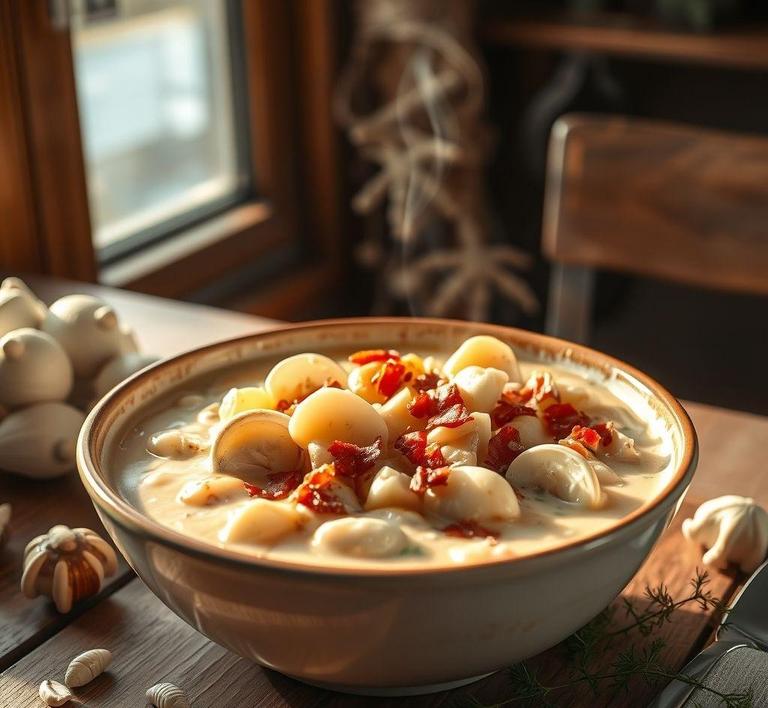If you’ve made a big batch of New England clam chowder and ended up with leftovers, you might be wondering whether it’s possible to refreeze it without sacrificing flavor or texture. Refreezing clam chowder can be a bit tricky due to its creamy base, but with the right techniques, you can enjoy that comforting bowl of chowder at a later date without worrying about it becoming a watery mess. In this guide, we’ll walk you through everything you need to know about refreezing New England clam chowder, from preparation tips to how to properly store it, so you can savor your favorite seafood soup when you’re craving it next time.
Can You Refreeze New England Clam Chowder?

The short answer: Yes, but with significant caveats.
New England clam chowder is a hearty soup made with a base of cream or milk, potatoes, clams, onions, and sometimes salt pork or bacon. Its luxurious texture and nuanced briny flavor make it a comfort food favorite. However, this very composition-dairy, seafood, and starchy vegetables-makes it especially delicate when it comes to freezing and refreezing.
If the chowder was previously frozen and then fully thawed, refreezing becomes a bit tricky. Technically, you can refreeze it if it was thawed in the refrigerator and has not been left out at room temperature for over 2 hours. However, just because you can doesn’t mean you should. Let’s explore why.
How To Refreeze New England Clam Chowder?
If you find yourself with leftover thawed clam chowder and don’t want it to go to waste, follow these steps meticulously to ensure food safety and preserve as much of the soup’s original quality as possible:
-
Check the Chowder’s Condition
- Ensure the chowder was thawed in the refrigerator, not on the counter.
- Confirm it hasn’t been reheated already. Once reheated, leftovers should not be frozen again.
-
Cool It Quickly
- If you’ve reheated the chowder and want to refreeze a portion, cool it as quickly as possible by placing the pot into an ice bath or dividing the chowder into shallow containers.
-
Use Airtight Containers
- Transfer the chowder into freezer-safe, airtight containers or heavy-duty freezer bags. Leave a little space at the top to allow for expansion.
-
Label and Date
- Mark the container with the date you are refreezing it, so you can track how long it’s been stored.
-
Freeze Promptly
- Place the container in the coldest part of your freezer (generally the back), ensuring it’s frozen as quickly as possible to preserve texture and flavor.
Quality Impact
This is where reality sets in. While refreezing is possible, the quality of New England clam chowder is almost always noticeably diminished after being frozen once-let alone twice.
-
Texture Degradation
- Cream-based soups tend to separate and become grainy or curdled after freezing and reheating. The emulsification of dairy breaks down, resulting in a less creamy, more watery consistency.
-
Potato Breakdown
- Potatoes are particularly vulnerable; their cell walls rupture during freezing, leading to a mushy, mealy texture upon thawing.
-
Flavor Loss
- Seafood like clams can become rubbery and lose their delicate ocean flavor, while the aromatic base of onion and bacon may become dull or overly intensified.
-
Risk of Foodborne Illness
- With any seafood and dairy combination, bacterial growth is a legitimate concern. If improperly handled during thawing and refreezing, it could lead to food safety issues. Err on the side of caution: when in doubt, throw it out.
Refreezing New England clam chowder is a culinary compromise. While it’s technically safe under the right conditions, the overall integrity of the dish suffers. The creamy texture you love may transform into something curdled and off-putting, and the potatoes and clams won’t be the same.
If you anticipate having leftovers, your best strategy is to freeze individual portions immediately after cooking. This not only avoids the need to refreeze but ensures that each serving retains the original quality as much as possible. And remember-some dishes are best enjoyed fresh, and clam chowder is definitely one of them.
Is It Safe To Refreeze New England Clam Chowder?
Refreezing New England clam chowder can be safe, but only under specific conditions. The creamy texture, dairy content, and presence of shellfish make this a particularly delicate soup to handle when it comes to temperature changes and food safety.
If the clam chowder was originally thawed in the refrigerator and has not been left at room temperature for more than two hours, then yes – it can be refrozen. However, every refreezing cycle can impact the texture and flavor. Cream-based chowders like this one are prone to separating when reheated, often resulting in a grainy or curdled consistency. Shellfish, too, may become rubbery or overly fishy upon refreezing and reheating.
So, while technically safe under the right conditions, refreezing New England clam chowder isn’t ideal from a quality standpoint. It’s best to freeze it only once and in individual portions to avoid unnecessary thaw-refreeze cycles.
Signs That New England Clam Chowder Should Not Be Refrozen
Before you even consider popping that leftover chowder back in the freezer, inspect it carefully. Here are the red flags that indicate refreezing would be unsafe or unwise:
- Off Smell: If your chowder has a sour, ammonia-like, or otherwise off-putting smell, it’s a strong indicator that bacterial growth has occurred. Do not refreeze.
- Discoloration: A healthy clam chowder should be creamy white or slightly beige. Any pink, green, or yellow discoloration, especially near the surface or edges, could point to mold or bacterial contamination.
- Separation or Curdling: While minor separation might be fixed upon reheating, significant clumping or curdling indicates the chowder has broken down and may not hold up well to another freeze-thaw cycle.
- Temperature Abuse: If the chowder sat at room temperature for over two hours – or one hour if the ambient temperature was above 90°F (32°C) – it has likely reached the bacterial danger zone (40°F-140°F), and refreezing would pose a risk of foodborne illness.
- Texture of Clams: If the clams have become mushy or disintegrated, this could signal spoilage. Fresh clams should remain slightly firm and plump, even after freezing.
Common Refreezing Mistakes
Even experienced home cooks can fall into a few traps when trying to refreeze soup. These are some of the most common and critical errors to avoid:
- Refreezing After Microwaving: Microwaving your chowder to thaw it often leads to uneven heating – with hot spots and cold centers. Refreezing after microwave thawing can allow harmful bacteria to flourish.
- Not Cooling Properly Before Freezing: Freezing hot soup may seem efficient, but it actually disrupts the freezing process and promotes ice crystal formation, which wrecks texture and increases freezer burn. Always cool chowder completely in an ice bath or in shallow containers in the fridge first.
- Refreezing Large Quantities: Each time you thaw a large batch and then refreeze leftovers, you increase the risk of spoilage. Divide into single portions to minimize repeated handling.
- Ignoring the ‘Two-Hour Rule’: This is one of the cardinal sins of food safety. Leaving chowder out on the counter for too long gives bacteria ample time to multiply – even if it still looks and smells fine.
Tips And Tricks
To help you enjoy your clam chowder safely and deliciously – even if you’re storing it for later – here are some best practices:
- Portion Wisely: Freeze individual portions in airtight containers or heavy-duty freezer bags. This makes thawing only what you need much easier and minimizes waste.
- Use Freezer-Safe Containers: Look for containers labeled “freezer-safe” to prevent cracking, leaking, or flavor absorption. Glass jars with wide mouths or silicone trays are great choices.
- Label with Dates: Chowder can be frozen for up to 2 months for best quality. Always write the freeze date on your container to track freshness.
- Reheat Gently: Thaw in the refrigerator overnight, and reheat slowly on the stovetop. Stir continuously over low heat to avoid curdling the cream base.
- Add Freshness Post-Thaw: To revive flavor, consider adding a touch of fresh cream, chopped parsley, or a squeeze of lemon after reheating. This can elevate the taste and texture after freezing.
Conclusion
Refreezing New England clam chowder is a culinary tightrope walk – doable, but only with careful attention to safety and quality. The richness of the cream and the delicacy of the shellfish make it especially susceptible to spoilage and texture changes.
The golden rule? Only refreeze if the chowder was thawed properly in the refrigerator, never left out too long, and still appears and smells fresh. Even then, be prepared for a slight decline in texture and taste. When possible, freeze in small portions after the first cook to avoid the need for refreezing altogether.
Handled with care, your chowder can remain a cozy, comforting treat – even from the depths of the freezer. Just let safety and good sense be your guiding lights in the kitchen.

